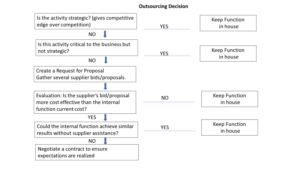

Outsourcing has always been a hot topic and a rather simple optional solution for companies to save money. Avoiding full time employee (FTE) expenses like benefits, salaries, etc. sounds appealing. Having an external resource doing the same job at a lesser cost sounds even more appealing! With all of this positivity being said about outsourcing, finding the right outsourcing partner can be tricky and complex. Hopefully this article will give you some insight into the do’s and don’ts of outsourcing and how to find the perfect vendor to partner with.
Benefits of Outsourcing
Outsourcing your procurement department can bring many benefits that will increase your shareholder value. But of course, there are pros and cons to everything. I’ve listed below some of the pros to outsourcing procurement activities:
- Allow you to focus on your core business
- Eliminate FTE costs including turnover costs
- Reduce risks
- Specialized and highly skilled procurement professionals
- Procurement negotiation experts proven to be more effective and profitable
These are just a few. On the con side, you will be losing control of the day to day procurement activities however, there is a way to mitigate this. Make sure you have a good Service Level Agreement (SLA) and achievable Key Performance Indicators (KPI’s). In addition, the key to a successful outsourcing arrangement is having strong, transparent, partnership. Read my recent article titled Client-Vendor Partnerships.
Risks of Outsourcing
Outsourcing can have additional risks and responsibilities that should be discussed during the negotiation stages of the RFP Process and throughout the term of the agreement. Developing outsourcing guidelines and/or an outsourcing policy will assist in outlining the risks/mitigations. All risks should be conveyed in your business case. Risks of outsourcing may include:
- Loss of control
- Unexpected fees
- Conversion costs
- Supplier risks such as slow implementation, poor quality and response time
- Lack of skilled resources
- Long term flexibility/the ability to meet changing business requirements
Make sure your agreement reflects provisions that protect your organization from potential risks. (Refer to Step 4) Seek legal advice when in doubt.
In House vs Outsource

Use the above flowchart to help you analyze whether or not outsourcing makes sense. Proper due diligence should be done before making that final outsourcing decision. The decision to outsource or not depends on a number of financial and non financial variables.
Here are some steps to guide you through this process.
Step 1 Prepare a Business Case
The purpose of any business case is to document the justification for the undertaking of a project, which in this case is procurement outsourcing. Key elements of a business case include the baseline, severance, transition and service delivery costs. It’s based on the estimated cost of development and implementation against the risks and the anticipated business benefits and savings to be gained. This step is key to any outsourcing initiative. Some companies put a lot of effort in developing a business case but fail to follow up after the implementation has been completed. Most commonly, positive financial results are not realized until the second or third year of the term. So, checking in afterwards is important to see if the actual business goal and benefits have been achieved.
Step 2 Obtaining Approval
The business case is complete and now it’s time to present the results to your project owner and senior leadership team. Be prepared to address their questions and ensure that the right resources including HR and Finance, are available to confirm the answers. You may find that not everyone agrees with outsourcing, even if there is savings to be gained, mostly due to the emotional attachments to employees. Outsourcing arrangements should be approved by the appropriate levels of authority.
Step 3 Finding the Right Vendor
Strategically sourcing the right vendor can be a complex and lengthy process. Companies should consider hiring a Procurement Consultant to handle this process as internal sourcing specialist don’t always have the expertise or the time to dedicate to these types of projects.
Meeting with prospective vendors prior to going to RFP may be a good idea. This allows for a more relaxed conversation as the vendor is not being evaluated using approved scoring criteria. The client will be able to obtain an overview and some insight into the company and their capabilities without any commitment or pressure. An alternative is to do a Request for Information (RFI). Doing an RFI will assist in collecting information about the vendor, their experience, abilities, skills etc. It may also help you to further define your requirements for an RFP.
Building a good RFP can be tedious and is dependent on the scope of work and detailed requirements. Make sure this information is clear and be specific about what you want and what you don’t want. Depending on the value and complexity of the project, the RFP should be posted anywhere from 4 to 12 weeks. Public sector RFP’s must be posted in compliance with the Broader Public Service (BPS) Procurement Directive. Preparing a good proposal takes time and effort so be sure to allow extra time, especially through holiday and summer seasons.
Remember, the selected vendor must not only be able to provide the service, but they must be the right fit “culturally” in order to blend in with your organization. This is especially true if the outsourced resources will have on site access to your facility. Ideally, the vendor’s business values and goals should align with yours. Make sure you ask the right questions in your RFP to determine this.
Step 4 What to include in your Outsourcing Agreement
Make sure you know and understand key outsourcing terminology and definitions. Words like attrition (staff turnover rates), audit access, benchmarking, business case, business continuity plans, change control procedures or change management, business process outsourcing (BPO), statement or work, sub contractors just to name a few. Most of these should also be included in your Outsourcing/Managed Services Agreement. Consulting with a procurement advisor and a legal resource will ensure that the proper language is articulated in the agreement. Refer to the information outlined in Step 3.
Below are some key elements that should appear in your agreement. (Note: exact legal language is not provided)
| Subcontracting: set out any rules or limitations to subcontracting by the vendor. Approvals should be obtained by the purchaser prior to vendor subcontracting any part of the service. To ensure privacy, security and confidentiality standards are met by all, the purchaser should have the right to audit and inspection. | Contingency Plan: include the vendor’s back up plan for ensuring the continuation of business in the event of a business disruption including strike, natural disaster, etc. |
| Audit Rights: clearly state auditing rights of both parties. Make sure you include the right to audit the vendor’s internal control environment with reasonable notice or on an annual basis. | Cost and Compensation: all costs should be clearly outlined for the service being provided. This includes any annual increases and or adjustments for labour, materials etc. |
| Insurance: include a copy of the most recent insurance policy for general liability, and errors and omissions, WSIB etc. The vendor should notify the purchaser of any changes to its insurance policy. | Performance Standards: define measurable performance standards for the services or products being provided. (SLA) |
| Dispute Resolution: include a process/protocol in order to expedite problems and issue. | Limits on liability: a limit based on the risk of the service if the vendor fails to perform |
| Reporting Requirements: reports delivered monthly, quarterly, annually, as the purchaser requests, to include overall vendor performance to ensure they are meeting service level objectives. | Continuous Improvement: a provision that commits the vendor to continuous improvement recommendations throughout the term of the contract. Vendor should be held accountable to provide future insight into their predicted long-term plan for process improvement.
|
| Privacy & Confidentiality: protection of all purchaser information consistent with applicable laws and policies. | Transition of Services: upon the expiration or termination of the Agreement, the vendor will provide all services necessary for an orderly transition of the Services being provided in an agreed upon timeframe, in whole or in part, to another vendor, including and without limitation the transfer of all records and other data in the possession, custody or control of the vendor at no cost to the purchaser. |
Conclusion:
Absorb the information that’s been provided and keep in mind that this is just the tip of the iceberg. There is more to outsourcing your services than letting a vendor do the work for you. Consider all of the above before proceeding with your project. Procurement outsourcing consists of evaluating the situation to determine if it’s a viable solution for your organization. Take your time and consult with internal business groups and external expertise for guidance and support.
I hope you found this article helpful! Contact me for a complimentary 15-minute consultation regarding this article and stay tuned for the next topic by Procurement Management Services Inc.
For more great tips, subscribe to my newsletter. https://procurementservicesinc.com/blog/

Recent Comments